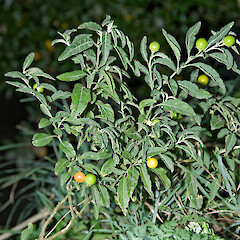Solanum diflorum
Common name
false Jerusalem cherry
Family
Solanaceae
Flora category
Vascular – Exotic
Structural class
Herbs - Dicotyledons other than Composites
NVS code
The National Vegetation Survey (NVS) Databank is a physical archive and electronic databank containing records of over 94,000 vegetation survey plots - including data from over 19,000 permanent plots. NVS maintains a standard set of species code abbreviations that correspond to standard scientific plant names from the Ngä Tipu o Aotearoa - New Zealand Plants database.
SOLDIF
Conservation status
Not applicable
Habitat
Terrestrial.
Detailed description
Small unarmed shrub with stems to about 50 cm tall. The leaves are quite variable is size but can reach up to 14 x 8 cm, entire or with wavy margins. Hairs on young stems and very young leaves dense, becoming less scattered on older stems and leaves. Flowers are white and are solitary or in small clusters. The berry is scarlet or orange-red, round and up to about 1.5 cm diameter, containing a seed up to 3mm long.
Similar taxa
Very similar to S. pseudocapsicum but can be distinguished by the hairs which are very dense on the young shoots and leaves but becoming scattered on older shoots and leaves. S. pseudocapsicum is almost always hairless.
Flowering
January, February, March, April, May, June, July, August, September, October, November, December
Flower colours
White
Life cycle
Spreads by seed which is dispersed by birds
Year naturalised
1958
Origin
Temperate eastern S. America
Reason for introduction
Ornamental
Tolerances
Appears to be quite shade tolerant and can establish under canopy.
Etymology
solanum: Derivation uncertain - possibly from the Latin word sol, meaning “sun,” referring to its status as a plant of the sun. Another possibility is that the root was solare, meaning “to soothe,” or solamen, meaning “a comfort,” which would refer to the soothing effects of the plant upon ingestion.
Poisonous plant
The red-orange berries are poisonous if eaten.



